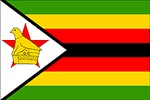Includes historical data for Zimbabwe’s Gross Domestic Product growth, debt-to-GDP ratio and more, as well as information on trade, banking and financial sector leadership.
Post-Independence Economic Malaise
After gaining independence from British colonial rule in 1980, this country of about 17 million people enjoyed some of the highest living standards on the continent. However, starting around 1995, the country entered a phase of prolonged economic decline, which was further exacerbated by a hyperinflation crisis that peaked in 2007 at nearly 25,000%, plunging Zimbabwe into turmoil.
The lingering effects continue to hinder entrepreneurial activity today. Supplemental weaknesses include an opaque regulatory environment, inadequate infrastructure, and vulnerability to fluctuations in commodity prices and climatic hazards. Despite the challenges, sectors like agribusiness, mining, energy and tourism hold strong potential. Additionally, the country’s skilled labor force and strategic location in Southern Africa as a gateway to regional markets enhance the economic appeal, positioning Zimbabwe as a prime destination for foreign direct investment (FDI) across the continent.
Macroeconomy & Sovereign Data
| Type of Government | Semi-presidential republic |
|---|---|
| Capital | Harare |
| Sovereign Ratings |
S&P: Not rated Moody’s: Not rated Fitch Ratings: Not rated |
| Total Population | 16.5 million |
| Median Age | 18.6 |
| Adult Per Capita Income (PPP) | 5,338.65 |
| Total GDP (2023) | 34.4 billion |
Zimbabwe GDP & Economic Overview
Most Recent Content
Banking & Finance
Trade & Investment
| Total Exports | USD 7.3 billion (2023) |
|---|---|
| Leading Exports |
Gold Tobacco Iron Alloys Nickel Diamonds Jewelry |
| Total Imports | USD 5.9 billion (2022) |
| Leading Imports |
Refined Petroleum Delivery Trucks Packaged Medicines Fertilizers Tractors |
| Source: | World Integrated Trade Solution |
Zimbabwe Leading Companies
| CBZ Bank | Financials |
|---|---|
| Innscor Africa | Consumer Staples, Food Products |
| National Foods | Consumer Staples, Food Products |
| Axia Corporation | Consumer Discretionary, Specialty Retail |
| OK Zimbabwe | Consumer Staples Distribution & Retail |
| Telecel | Telecommunication Services |
| Meikles Limited | Conglomerate, Real Estate, Retail, Financials |
Major Trade Partners — Import
| South Africa | 43% |
|---|---|
| Singapore | 14% |
| China | 12% |
| Mozambique | 3% |
| Mauritius | 3% |
Source: World Integrated Trade Solution
Major Trade Partners — Export
| South Africa | 48% |
|---|---|
| United Arab Emirates | 29% |
| Mozambique | 8% |
| China | 4% |
| Unspecified | 4% |
Source: World Integrated Trade Solution
Global Finance Rankings & Awards
Data Sources:
UN World Population Prospects
World Inequality Report
S&P Global Ratings
Moody’s
Fitch Ratings
IMF Direction of Trade Statistics (DOTS)
UN Conference on Trade and Development (UNCTAD)
CIA The World Factbook
World Bank’s World Integrated Trade Solution
Forbes Global 2000



